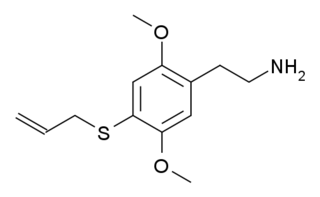
Dimethoxybromoamphetamine (DOB), also known as brolamfetamine (INN) and bromo-DMA, is a psychedelic drug and substituted amphetamine of the phenethylamine class of compounds. DOB was first synthesized by Alexander Shulgin in 1967. Its synthesis and effects are documented in Shulgin's book PiHKAL: A Chemical Love Story.

N-Methyl-N-ethyltryptamine (MET) is a psychedelic tryptamine. It is closely related to DMT and DET. The Lysergamide counterpart of MET is ETH-LAD, an analogue of LSD first developed and characterized by Alexander Shulgin.

David Earl Nichols is an American pharmacologist and medicinal chemist. Previously the Robert C. and Charlotte P. Anderson Distinguished Chair in Pharmacology at Purdue University, Nichols has worked in the field of psychoactive drugs since 1969. While still a graduate student, he patented the method that is used to make the optical isomers of hallucinogenic amphetamines. His contributions include the synthesis and reporting of escaline, LSZ, 6-APB, 2C-I-NBOMe and other NBOMe variants, and several others, as well as the coining of the term "entactogen".

Amides of lysergic acid are collectively known as lysergamides, and include a number of compounds with potent agonist and/or antagonist activity at various serotonin and dopamine receptors. Lysergamides contain an embedded tryptamine structure, and as a result can produce similar, often psychedelic, effects to those of the true tryptamines.

ALD-52, also known as 1-acetyl-LSD, has chemical structural features similar to lysergic acid diethylamide (LSD), a known psychedelic drug. Similarly, ALD-52 has been reported to produce psychoactive effects, but its pharmacological effects on humans are poorly understood. Given its psychoactive properties, it has been reported to be consumed as a recreational drug, and the purported first confirmed detection of the substance on the illicit market occurred in April 2016.

2C-BFLY is a psychedelic phenethylamine and designer drug of the 2C family. It was first synthesized in 1996 by Aaron Monte, Professor of Chemistry at UW-La Crosse.

AL-LAD, also known as 6-allyl-6-nor-LSD, is a psychedelic drug and an analog of lysergic acid diethylamide (LSD). It is described by Alexander Shulgin in the book TiHKAL. It is synthesized starting from nor-LSD as a precursor, using allyl bromide as a reactant.

ETH-LAD, 6-ethyl-6-nor-lysergic acid diethylamide is an analogue of LSD. Its human psychopharmacology was first described by Alexander Shulgin in the book TiHKAL. ETH-LAD is a psychedelic drug similar to LSD, and is slightly more potent than LSD itself, with an active dose reported at between 20 and 150 micrograms. ETH-LAD has subtly different effects to LSD, described as less demanding. The true tryptamine counterpart of ETH-LAD is MET, a simplified version of this structure.

PRO-LAD is an analogue of LSD. It is described by Alexander Shulgin in the book TiHKAL. PRO-LAD is a psychedelic drug similar to LSD, and is around as potent as LSD itself with an active dose reported at between 100 and 200 micrograms.

BU-LAD, also known as 6-butyl-6-nor-lysergic acid diethylamide, is an analogue of LSD first made by Alexander Shulgin and reported in the book TiHKAL. BU-LAD is a psychedelic drug similar to LSD, but is significantly less potent than LSD, with a dose of 500 micrograms producing only mild effects.

PARGY-LAD is an analogue of LSD. It is described by Alexander Shulgin in the book TiHKAL. PARGY-LAD is a hallucinogenic drug similar to LSD, but is considerably less potent than LSD with a dose of 160 micrograms producing only mild effects, and 500 micrograms required for full activity.

N-Morpholinyllysergamide (LSM-775) is a derivative of ergine. It is less potent than LSD but is reported to have some LSD-like effects at doses ranging from 75 to 700 micrograms and a shorter duration. There are fewer signs of cardiovascular stimulation and peripheral toxicity with LSM-775 compared to LSD.

N,N-Dimethyllysergamide or N,N-dimethyl-D-lysergamide (DAM-57) is a derivative of ergine. There has been a single report of observing N,N-dimethyl-D-lysergamide in the illicit drug market. This compound did induce autonomic disturbances at oral levels of some ten times the dosage required for LSD, presumably in the high hundreds of micrograms. There is some disagreement as to whether there were psychic changes observed.

Dimethoxy-4-amylamphetamine (DOAM) is a lesser-known psychedelic drug and a substituted amphetamine. DOAM was first synthesized by Alexander Shulgin. In his book PiHKAL (Phenethylamines i Have Known And Loved), the minimum dosage is listed as 10 mg, and the duration is unknown. DOAM produces a bare threshold and tenseness. As the 4-alkyl chain length is increased from shorter homologues such as DOM, DOET and DOPR which are all potent hallucinogens, the 5-HT2 binding affinity increases, rising to a maximum with the 4-(n-hexyl) derivative before falling again with even longer chains, but compounds with chain length longer than n-propyl, or with other bulky groups such as isopropyl, t-butyl or γ-phenylpropyl at the 4- position, fail to substitute for hallucinogens in animals or produce hallucinogenic effects in humans, suggesting these have low efficacy and are thus antagonists or partial agonists at the 5-HT2A receptor.

2,5-Dimethoxy-4-ethoxyamphetamine (MEM) is a psychedelic drug of the phenethylamine and amphetamine chemical classes. It was first synthesized by Alexander Shulgin. In his book PiHKAL, he lists the active dose range as 20–50 mg, and the duration as 10–14 hours. According to Shulgin, MEM produces color enhancement, visual phenomena, and pattern movement, among other effects.

Lysergic acid 2-butyl amide (2-Butyllysergamide, LSB) is an analogue of LSD originally developed by Richard Pioch at Eli Lilly in the 1950s, but mostly publicised through research conducted by the team led by David E. Nichols at Purdue University. It is a structural isomer of LSD, with the two ethyl groups on the amide nitrogen having been replaced by a single sec-butyl group, joined at the 2-position. It is one of the few lysergamide derivatives to exceed the potency of LSD in animal drug discrimination assays, with the (R) isomer having an ED50 of 33nmol/kg for producing drug-appropriate responding, vs 48nmol/kg for LSD itself. The corresponding (R)-2-pentyl analogue has higher binding affinity for the 5-HT1A and 5-HT2A receptors, but is less potent in producing drug-appropriate responding, suggesting that the butyl compound has a higher efficacy at the receptor target. The drug discrimination assay for LSD in rats involves both 5-HT1A and 5-HT2A mediated components, and while lysergic acid 2-butyl amide is more potent than LSD as a 5-HT1A agonist, it is slightly less potent as a 5-HT2A agonist, and so would probably be slightly less potent than LSD as a hallucinogen in humans. The main use for this drug has been in studies of the binding site at the 5-HT2A receptor through which LSD exerts most of its pharmacological effects, with the stereoselective activity of these unsymmetric monoalkyl lysergamides foreshadowing the subsequent development of compounds such as lysergic acid 2,4-dimethylazetidide (LSZ).

4-Substituted-2,5-dimethoxyamphetamines (DOx) is a chemical class of substituted amphetamine derivatives featuring methoxy groups at the 2- and 5- positions of the phenyl ring, and a substituent such as alkyl or halogen at the 4- position of the phenyl ring. Most compounds of this class are potent and long-lasting psychedelic drugs, and act as highly selective 5-HT2A, 5-HT2B, and 5-HT2C receptor partial agonists. A few bulkier derivatives such as DOAM have similarly high binding affinity for 5-HT2 receptors but instead act as antagonists, and so do not produce psychedelic effects though they retain amphetamine-like stimulant effects.

4-HO-DsBT (4-hydroxy-N,N-di-sec-butyltryptamine) is a tryptamine derivative which acts as a serotonin receptor agonist. It was first made by Alexander Shulgin and is mentioned in his book TiHKAL, but was never tested by him. However it has subsequently been tested in vitro and unlike the n-butyl and isobutyl isomers which are much weaker, the s-butyl derivative retains reasonable potency, with a similar 5-HT2A receptor affinity to MiPT but better selectivity over the 5-HT1A and 5-HT2B subtypes.

2C-T-16 is a lesser-known psychedelic drug. It was originally named by Alexander Shulgin as described in his book PiHKAL, however while Shulgin began synthesis of this compound he only got as far as the nitrostyrene intermediate, and did not complete the final synthetic step. Synthesis of 2C-T-16 was finally achieved by Daniel Trachsel some years later, and it was subsequently reported as showing similar psychedelic activity to related compounds, with a dose range of 10–25 mg and a duration of 4–6 hours, making it around the same potency as the better-known saturated analogue 2C-T-7, but with a significantly shorter duration of action. Binding studies in vitro showed 2C-T-16 to have a binding affinity of 44 nM at 5-HT2A and 15 nM at 5-HT2C. 2C-T-16 and related derivatives are potent partial agonists of the 5-HT1A, 5-HT2A, 5-HT2B and 5-HT2C receptors and induce a head-twitch response in mice.

1V-LSD, sometimes nicknamed Valerie, is a psychotropic substance and a research chemical with psychedelic effects. 1V-LSD is an artificial derivative of natural lysergic acid, which occurs in ergot alkaloids, as well as being an analogue of LSD. 1V-LSD has been sold online until an amendment to the German NpSG was enforced in 2022 which controls 1P-LSD and now 1cP-LSD, 1V-LSD and several other lysergamides.




















